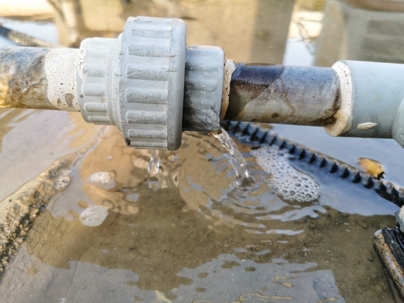Have you ever found your air conditioner leaking water? This might come as a somewhat shocking problem, seeing as air conditioners are thought to be an HVAC appliance and not one that deals with plumbing. However, by their very nature, air conditioners create a lot of water as runoff, and this water all needs to be properly handled. If the water doesn’t have somewhere to go, it quickly builds up and creates a problem that can cause water damage in your home and be rather difficult to deal with.
AC & the Challenge of Condensation
If the first question you ask yourself after finding your air conditioner dripping water is “How is that possible if my AC isn’t connected to a water source?” you certainly aren’t alone. Air conditioners are not connected to a water line, so where is all of that water coming from? The answer is a simple one: from the air. Air contains a percentage of water vapor, or water that has evaporated into a gaseous form, sort of like how water turns into steam when it boils.
When this gas-form water becomes cold enough, it turns back into a liquid form through a process known as condensation. You probably see this happen quite a lot in your daily life, such as when you pour yourself a glass of ice water and the outside of the glass becomes wet to the touch within a few minutes. The water on the outside of the glass used to be in the air, but turned back into a liquid form and stuck to the glass thanks to the cold outside surface.
This same principle happens in your air conditioner. When freezing-cold refrigerant runs through the metal coil inside your air conditioner’s indoor unit, the surface of the coil becomes extremely cold as well. As air is forced over the coil, any water vapor in the air that makes contact with the surface of the coil rapidly condenses into a liquid form. Initially, this starts as a thin layer of moisture on the coil itself, but before long the water builds up into large drops, and those large drops turn into a pretty substantial stream of water dripping down from the coil itself.
Your AC’s Drain Pan & Drain Line
So now that we have established why water forms in your air conditioner, let’s take a closer look at how your system is built to handle this challenge. Every air conditioner has an important component known as a drain pan. Your drain pan is a metal collection pan located beneath your condensing coil. As the water drips off of the coil, it collects in this pan. Located at the bottom of this pan is a small pipe known as a drain line. This isn’t all that unlike any other drain in your home—it carries away collected water away from your air conditioner and disposes of it where it is safe to do so.
However, it can only do this so long as your drain line isn’t clogged, jammed, or otherwise blocked by an obstruction. This isn’t all that uncommon—dust and debris can build up in a drain pan where it can be washed into the line as water flows through it. Mud and dirt can get into a drain line from the exit. Even small animals can crawl into the drain line itself, seeking a source of shelter or refuge from the elements outside. Any significant blockage in a drain line can prevent the drain from removing the collected condensation from your air conditioner, and this is when you find yourself dealing with the problem of water leaking out of your air conditioner.
How to Fix a Blocked Drain Line
Fixing a blocked or plugged drain line doesn’t have to be difficult. If the blockage is located fairly close to your air conditioner itself, using a straightened coat hanger to dislodge the obstruction or pull it out of the line can free it up and allow water to flow through smoothly again. However, a blockage in the middle of the line could be a bit trickier to deal with. One trick some people swear by is to boil a pot of water and then pour the boiling water down your drain line to try and melt anything in the line that could be easily soluble. Alternatively, it’s not a bad idea to regularly clean your condensation line to prevent any algae or mold growth from blocking the line. Simply pour a cup of bleach down your drain line and then wash it down with a steady stream of water and your drain line should remain clear and free for the next several months.
If you have a problem with your condensation drain line, your drain pan, or any other part of your air conditioner, call the team at Carter Services at (310) 872-1898 and schedule an air conditioning repair!
